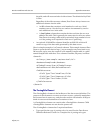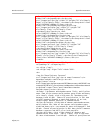
Data Source Definition File Overview Appendix B: Data Parser
Polycom, Inc. 175
<SearchText>Football</SearchText>
<NewText>Baseball</NewText>
</ParsingRule>
The following parsing rule sets the value of the City container to "New York,
NY".
<ParsingRule Type="SetValue" Result="City">
<Value>New York, NY</Value>
</ParsingRule>
The following parsing rule replaces all occurrences of "Vanilla" with
"Chocolate" in the original text of the data feed. Note how the special "Source"
container is being overwritten by this parsing rule - after running this rule, the
special "Source" container will no longer contain the word "Vanilla".
<ParsingRule Type="Replace" Source="Source" Result="Source">
<SearchText>Vanilla</SearchText>
<NewText>Chocolate</NewText>
</ParsingRule>
The following parsing rule uses a taggable parameter to replace all
occurrences of the two lines
Fred Flintstone
Barney Rubble
with the single word "Dino".
<ParsingRule Type="Replace" Source="Source" Result="Source">
<SearchText>Fred Flintstone<crlf>BarneyRubble</SearchText>
<NewText>Dino</NewText>
</ParsingRule>
The following parsing rule uses a taggable parameter to replace all
occurrences of "Somebody" with the contents of the container called
PersonName.
<ParsingRule Type="Replace" Source="Source" Result="Source">
<SearchText>Somebody</SearchText>
<NewText>|PersonName|</NewText>
</ParsingRule>
The DataItem Element
<DataItem> elements are used to repeatedly apply a list of parsing rules. This
allows Data Parser to fill a table with multiple rows of data. For example, the
headlines from a news feed could be inserted, one per row, in a table.
The <DataItem> element has two optional attributes:


















